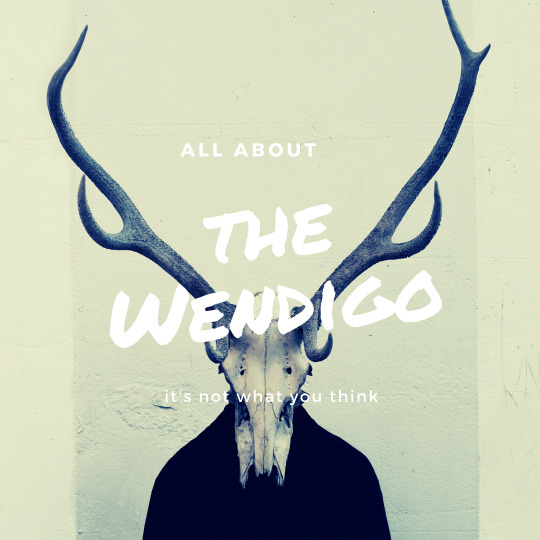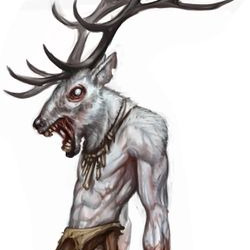#if you need a place to channel your deerman aesthetic
Text
The Wendigo is Not What You Think
There’s been a recent flurry of discussion surrounding the Wendigo -- what it is, how it appears in fiction, and whether non-Native creators should even be using it in their stories. This post is dedicated to @halfbloodlycan, who brought the discourse to my attention.
Once you begin teasing apart the modern depictions of this controversial monster, an interesting pattern emerges -- namely, that what pop culture generally thinks of as the “wendigo” is a figure and aesthetic that has almost nothing in common with its Native American roots...but a whole lot in common with European Folklore.

What Is A Wendigo?
The Algonquian Peoples, a cluster of tribes indigenous to the region of the Great Lakes and Eastern Seaboard of Canada and the northern U.S., are the origin of Wendigo mythology. For them, the Wendigo (also "windigo" or "Witigo" and similar variations) is a malevolent spirit. It is connected to winter by way of cold, desolation, and selfishness. It is a spirit of destruction and environmental decay. It is pure evil, and the kind of thing that people in the culture don't like to talk about openly for fear of inviting its attention.
Individual people can turn into the Wendigo (or be possessed by one, depending on the flavor of the story), sometimes through dreams or curses but most commonly through engaging in cannibalism. Considering the long, harsh winters in the region, it makes sense that the cultural mythology would address the cannibalism taboo.
For some, the possession of the Wendigo spirit is a very real thing, not just a story told around the campfire. So-called "wendigo psychosis" has been described as a "culture-bound" mental illness where an individual is overcome with a desire to eat people and the certainty that he or she has been possessed by a Wendigo or is turning into a Wendigo. Obviously, it was white people encountering the phenomenon who thought to call it "psychosis," and there's some debate surrounding the whole concept from a psychological, historical, and anthropological standpoint which I won't get into here -- but the important point here is that the Algonquian people take this very seriously. (1) (2)
(If you're interested in this angle, you might want to read about the history of Zhauwuno-geezhigo-gaubow (or Jack Fiddler), a shaman who was known as something of a Wendigo hunter. I'd also recommend the novel Bone White by Ronald Malfi as a pretty good example of how these themes can be explored without being too culturally appropriative or disrespectful.)
Wendigo Depictions in Pop Culture
Show of hands: How many of you reading this right now first heard of the Wendigo in the Alvin Schwartz Scary Stories to Tell in the Dark book?
That certainly was my first encounter with the tale. It was one of my favorite stories in the book as a little kid. It tells about a rich man who goes hunting deep in the wilderness, where people rarely go. He finds a guide who desperately needs the money and agrees to go, but the guide is nervous throughout the night as the wind howls outside until he at last bursts outside and takes off running. His tracks can be found in the snow, farther and farther apart as though running at great speed before abruptly ending. The idea being that he was being dragged along by a wind-borne spirit that eventually picked him up and swept him away.
Schwartz references the story as a summer camp tale well-known in the Northeastern U.S., collected from a professor who heard it in the 1930s. He also credits Algernon Blackwood with writing a literary treatment of the tale -- and indeed, Blackwood's 1910 novella "The Wendigo" has been highly influential in the modern concept of the story.(3) His Wendigo would even go on to find a place in Cthulhu Mythos thanks to August Derleth.
Never mind, of course, that no part of Blackwood's story has anything in common with the traditional Wendigo myth. It seems pretty obvious to me that he likely heard reference of a Northern monster called a "windigo," made a mental association with "wind," and came up with the monster for his story.
And so would begin a long history of white people re-imagining the sacred (and deeply frightening) folklore of Native people into...well, something else.
Through the intervening decades, adaptations show up in multiple places. Stephen King's Pet Sematary uses it as a possible explanation for the dark magic of the cemetery's resurrectionist powers. A yeti-like version appears as a monster in Marvel Comics to serve as a villain against the Hulk. Versions show up in popular TV shows like Supernatural and Hannibal. There's even, inexplicably, a Christmas episode of Duck Tales featuring a watered-down Wendigo.
Where Did The Antlered Zombie-Deer-Man Come From?
In its native mythology, the Wendigo is sometimes described as a giant with a heart of ice. It is sometimes skeletal and emaciated, and sometimes deformed. It may be missing its lips and toes (like frostbite). (4)
So why, when most contemporary (white) people think of Wendigo, is the first image that comes to mind something like this?

Well...perhaps we can thank a filmmaker named Larry Fessenden, who appears to be the first person to popularize an antlered Wendigo monster. (5) His 2001 film (titled, creatively enough, Wendigo) very briefly features a sort of skeletal deer-monster. He’d re-visit the design concept in his 2006 film, The Last Winter. Reportedly, Fessenden was inspired by a story he’d heard in his childhood involving deer-monsters in the frozen north, which he connected in his mind to the Algernon Blackwood story.
A very similar design would show up in the tabletop game Pathfinder, where the “zombie deer-man” aesthetic was fully developed and would go on to spawn all sorts of fan-art and imitation. (6) The Pathfinder variant does draw on actual Wendigo mythology -- tying it back to themes of privation, greed, and cannibalism -- but the design itself is completely removed from Native folklore.
Interestingly, there are creatures in Native folklore that take the shape of deer-people -- the ijiraq or tariaksuq, shape-shifting spirits that sometimes take on the shape of caribou and sometimes appear in Inuit art in the form of man-caribou hybrids (7). Frustratingly, the ijiraq are also part of Pathfinder, which can make it a bit hard to find authentic representations vs pop culture reimaginings. But it’s very possible that someone hearing vague stories of northern Native American tribes encountering evil deer-spirits could get attached to the Wendigo, despite the tribes in question being culturally distinct and living on opposite sides of the continent.
That “wendigo” is such an easy word to say in English probably has a whole lot to do with why it gets appropriated so much, and why so many unrelated things get smashed in with it.
I Love the Aesthetic But Don’t Want to Be Disrespectful, What Do I Do?
Plundering folklore for creature design is a tried-and-true part of how art develops, and mythology has been re-interpreted and adapted countless times into new stories -- that’s how the whole mythology thing works.
But when it comes to Native American mythology, it’s a good idea to apply a light touch. As I’ve talked about before, Native representation in modern media is severely lacking. Modern Native people are the survivors of centuries of literal and cultural genocide, and a good chunk of their heritage, language, and stories have been lost to history because white people forcibly indoctrinated Native children into assimilating. So when those stories get taken, poorly adapted, and sent back out into the public consciousness as make-believe movie monsters, it really is an act of erasure and violence, no matter the intentions of the person doing it. (8)
So, like...maybe don’t do that?
I won’t say that non-Native people can’t be interested in Wendigo stories or tell stories inspired by the myth. But if you’re going to do it, either do it respectfully and with a great deal of research to get it accurate...or use the inspiration to tell a different type of story that doesn’t directly appropriate or over-write the mythology (see above: my recommendation for Bone White).
But if your real interest is in the “wendigocore” aesthetic -- an ancient and powerful forest protector, malevolent but fiercely protective of nature, imagery of deer and death and decay -- I have some good news: None of those things are really tied uniquely to Native American mythology, nor do they have anything in common with the real Wendigo.
Where they do have a longstanding mythic framework? Europe.
Europeans have had a long-standing fascination with deer, goats, and horned/antlered forest figures. Mythology of white stags and wild hunts, deer as fairy cattle, Pan, Baphomet, Cernunnos, Herne the Hunter, Black Phillip and depictions of Satan -- the imagery shows up again and again throughout Greek, Roman, and British myth. (9)
Of course, some of these images and figures are themselves the product of cultural appropriation, ancient religions and deities stolen, plundered, demonized and erased by Christian influences. But their collective existence has been a part of “white” culture for centuries, and is probably a big part of the reason why the idea of a mysterious antlered forest-god has stuck so swiftly and firmly in our minds, going so far as to latch on to a very different myth. (Something similar has happened to modern Jersey Devil design interpretations. Deer skulls with their tangle of magnificent antlers are just too striking of a visual to resist).
Seriously. There are so, so many deer-related myths throughout the world’s history -- if aesthetic is what you’re after, why limit yourself to an (inaccurate) Wendigo interpretation? (10)
So here’s my action plan for you, fellow white person:
Stop referring to anything with antlers as a Wendigo, especially when it’s very clearly meant to be its own thing (the Beast in Over the Garden Wall, Ainsworth in Magus Bride)
Stop “reimagining” the mythology of people whose culture has already been targeted by a systematic erasure and genocide
Come up with a new, easy-to-say, awesome name for “rotting deer man, spirit of the forest” and develop a mythology for it that doesn’t center on cannibalism
We can handle that, right?
This deep dive is supported by Ko-Fi donations. If you’d like to see more content, please drop a tip in my tip jar. Ko-fi.com/A57355UN
NOTES:
1 - https://io9.gizmodo.com/wendigo-psychosis-the-probably-fake-disease-that-turns-5946814
2 - https://en.wikipedia.org/wiki/Wendigo#Wendigo_psychosis
3 - https://www.gutenberg.org/files/10897/10897-h/10897-h.htm
4 - https://www.legendsofamerica.com/mn-wendigo/
5- https://www.reddit.com/r/Cryptozoology/comments/8wu2nq/wendigo_brief_history_of_the_modern_antlers_and/
6 - https://pathfinderwiki.com/wiki/Wendigo
7 - https://www.mythicalcreaturescatalogue.com/single-post/2017/12/06/Ijiraq
8 - https://www.backstoryradio.org/blog/the-mythology-and-misrepresentation-of-the-windigo/
9 - https://www.terriwindling.com/blog/2014/12/the-folklore-of-goats.html
10 - https://en.wikipedia.org/wiki/Deer_in_mythology
#horror#folklore#mythology#deep dive#wendigo#cultural appropriation#monster design#creature design#long post#if you need a place to channel your deerman aesthetic#may I suggest huntokar from welcome to nightvale#100% fictional#100% awesome
179 notes
·
View notes